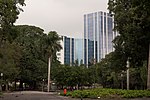Bairro de Fátima
Geography of Rio de Janeiro (city)Rio de Janeiro (state) geography stubs
Bairro de Fátima is a region of Rio de Janeiro, but not officially recognized as a neighborhood.
Excerpt from the Wikipedia article Bairro de Fátima (License: CC BY-SA 3.0, Authors).Bairro de Fátima
Rua Cardeal Dom Sebastião Leme, Rio de Janeiro Santa Teresa (Zona Central do Rio de Janeiro)
Geographical coordinates (GPS) Address Nearby Places Show on map
Geographical coordinates (GPS)
| Latitude | Longitude |
|---|---|
| N -22.916666666667 ° | E -43.188888888889 ° |
Address
Rua Cardeal Dom Sebastião Leme
Rua Cardeal Dom Sebastião Leme
20240-050 Rio de Janeiro, Santa Teresa (Zona Central do Rio de Janeiro)
Rio de Janeiro, Brazil
Open on Google Maps









